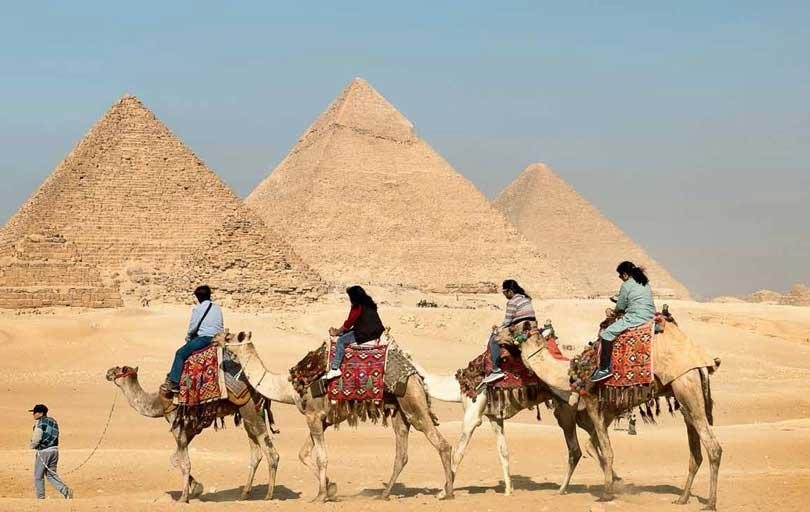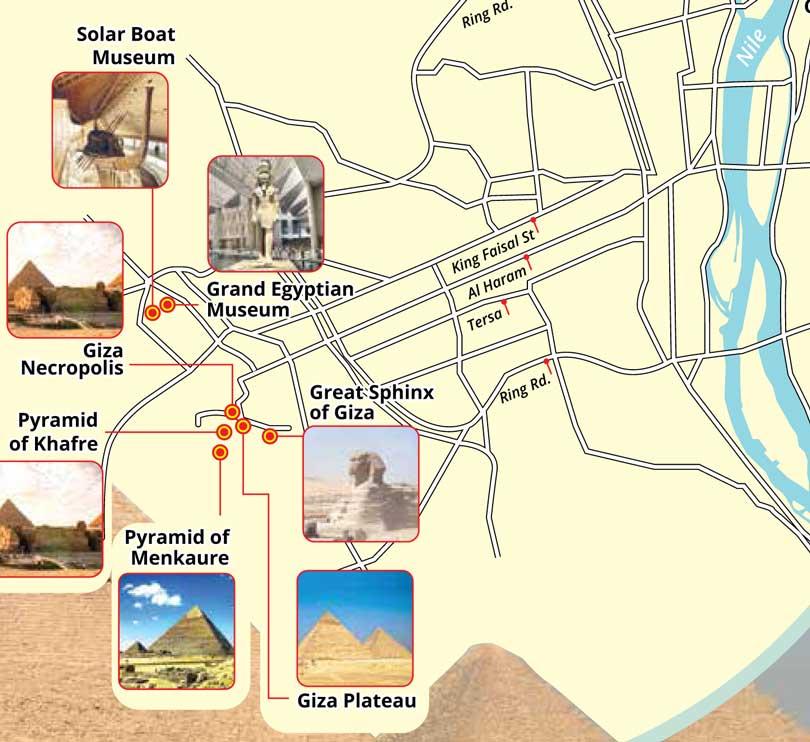




On the western edge of the Nile, where the golden sands of the desert meet the fertile breath of the river, lies a place that has captivated humanity for more than 4,500 years the Giza Necropolis. It is a city of silence and eternity, a landscape shaped not by nature, but by the hands of ancient visionaries who believed in forever. Here, under Egypt’s sun, stand the colossal Pyramids of Giza the last surviving wonder of the ancient world along with the Great Sphinx, mysterious tombs, and the echoes of an empire that once ruled the world’s imagination. To walk through Giza is to walk through time itself, a timeless conversation between stone, spirit, and sky.
When the ancient Egyptians built Giza, they were not simply creating monuments; they were crafting a pathway to eternity. The site was conceived as a sacred landscape a bridge between life and the afterlife. Around 2600 BCE, during Egypt’s Fourth Dynasty, Pharaoh Khufu (Cheops) began constructing his monumental pyramid, soon followed by his son Khafre and grandson Menkaure. Together, their pyramids form the iconic trio that dominates the Giza Plateau. Each pyramid was more than a tomb. It was a statement of divine power a proclamation that the pharaohs were not mere mortals, but gods destined to live among the stars. The structures were designed with cosmic precision Their sides align almost perfectly with the cardinal directions, and the Great Pyramid’s base is oriented with astonishing mathematical accuracy.
Archaeologists and historians still debate how such immense structures were built with Bronze Age technology. Millions of limestone and granite blocks, some weighing up to 80 tons, were cut, hauled, and set in place with incredible precision. Yet, beyond the engineering, what endures most is the spirit, the audacity of human belief that reached for eternity and succeeded. The largest of them all, the Great Pyramid of Khufu, once stood at 146 meters (480 feet) high the tallest man-made structure on Earth for nearly 4,000 years. Even today, though slightly reduced by erosion and missing its smooth white casing stones, it remains a sight that humbles every visitor.
Inside, narrow passageways descend into deep chambers and climb toward mysterious corridors. There is the King’s Chamber, where Khufu was once laid to rest in a red granite sarcophagus; the Queen’s Chamber, whose purpose remains uncertain and the Grand Gallery, an architectural marvel that rises like a stone canyon. Standing inside, one can almost feel the pulse of history the whisper of workers who toiled under the desert sun, the quiet rituals of priests preparing their king for his journey into the afterlife, and the weight of centuries that followed.
A short distance away, carved directly from a limestone outcrop, lies another symbol of Egypt’s eternal mystery the Great Sphinx of Giza. With the body of a lion and the face of a pharaoh (believed to be Khafre), the Sphinx gazes eastward toward the rising sun, as though watching over both life and death. At 73 meters long and 20 meters high, the Sphinx has endured millennia of wind, sand, and war. Its expression serene, proud, and unreadable has fascinated generations. Legends tell of secret chambers beneath it, hidden passages leading to the pyramids, and prophecies carved in forgotten tongues. Though many mysteries remain unsolved, one truth is clear: the Sphinx is the soul of Giza stoic, ancient, and eternal.
The second pyramid, built by Pharaoh Khafre, appears taller than Khufu’s only because it stands on higher ground. Its summit still bears fragments of the original white limestone casing, giving visitors a glimpse of how the pyramids once gleamed radiant beacons visible for miles across the desert. Next to Khafre’s pyramid lies the Sphinx, part of a grand funerary complex that included temples, causeways, and mortuary shrines. Every structure here was part of a cosmic plan, a reflection of the pharaoh’s journey from earthly ruler to divine being.
The smallest of the three, the Pyramid of Menkaure, may be less imposing in scale, but it holds its own charm. Built with bands of pink granite from Aswan, it reflects a refinement in both architecture and art. Near it, archaeologists discovered statues depicting Menkaure with his queen a rare and touching image of shared power and humanity amid divine grandeur. For centuries, Giza lay silent, its secrets buried under shifting sands. But it never truly disappeared. Pilgrims, scholars, and explorers from Greece, Rome, and beyond came to marvel at the site. When Napoleon’s troops arrived in 1798, he is said to have told his men, “Soldiers, from the top of these pyramids, forty centuries look down upon you.”
Today, the Giza Plateau is one of the world’s most visited archaeological sites, drawing millions of travelers each year. Yet despite the crowds, there are moments when time seems to stand still at sunrise, when the desert glows gold, or at sunset, when the pyramids turn crimson under the fading light. In those moments, the silence returns, and the weight of history feels almost tangible. Recent excavations have revealed the workers’ village a thriving community of craftsmen, bakers, and engineers who built these monuments. Far from slaves, they were skilled laborers, well-fed and respected, united by a shared purpose: to build eternity in stone.
Walking through the Giza Necropolis today is a humbling experience. You move between stones older than most civilizations yet still standing with perfect dignity. Each block, each hieroglyph, each shadow tells a story not of death, but of continuity. The ancient Egyptians believed the west was the land of the dead, where the sun set, and souls began their eternal journey. The placement of Giza, west of the Nile, was intentional a metaphor of rebirth, a promise that life continued beyond the horizon. That belief, carved into stone and sealed in geometry, still resonates. The pyramids were never built to mourn; they were built to celebrate eternity.
Modern visitors can explore the site easily from Cairo, just 20 kilometers away. Approaching the plateau, you see the pyramids rise from the haze immense, silent, almost surreal. Guided tours lead inside the Great Pyramid, through chambers where the air feels ancient, and to panoramic viewpoints where all three pyramids and the Sphinx align against the desert sky. Nearby, the Solar Boat Museum houses the restored wooden vessel buried beside Khufu’s pyramid intended to carry the pharaoh across the heavens. The Giza plateau also now includes a visitor center and the upcoming Grand Egyptian Museum, which will showcase treasures never before displayed to the world.
Whether you come for history, mystery, or sheer wonder, Giza gives you more than sights it gives you perspective. Standing beneath the Great Pyramid, you feel small, but not insignificant. You feel part of something vast and eternal the same awe that inspired kings, poets, and dreamers across millennia.
As the sun dips below the horizon, the pyramids glow one last time gold fading to amber, then to shadow. The desert grows quiet. The stars emerge, just as they did 4,500 years ago when the first blocks were laid. And in that stillness, the meaning of Giza becomes clear. These are not ruins. They are reminders.
Reminders of what humanity can dream, build, and believe. Reminders that even time itself must bow before the will to endure. Reminders that eternity, once imagined, can be made real in stone, in sky, in memory. The Giza Necropolis stands not as a monument to death, but as a celebration of forever.











